Last updated on February 19th, 2023 at 07:41 pm
This tender, moist Orange Bundt Cake recipe is bursting with citrus and wears a pretty in pink blood orange glaze. Enjoy a slice during citrus season with your coffee or tea!
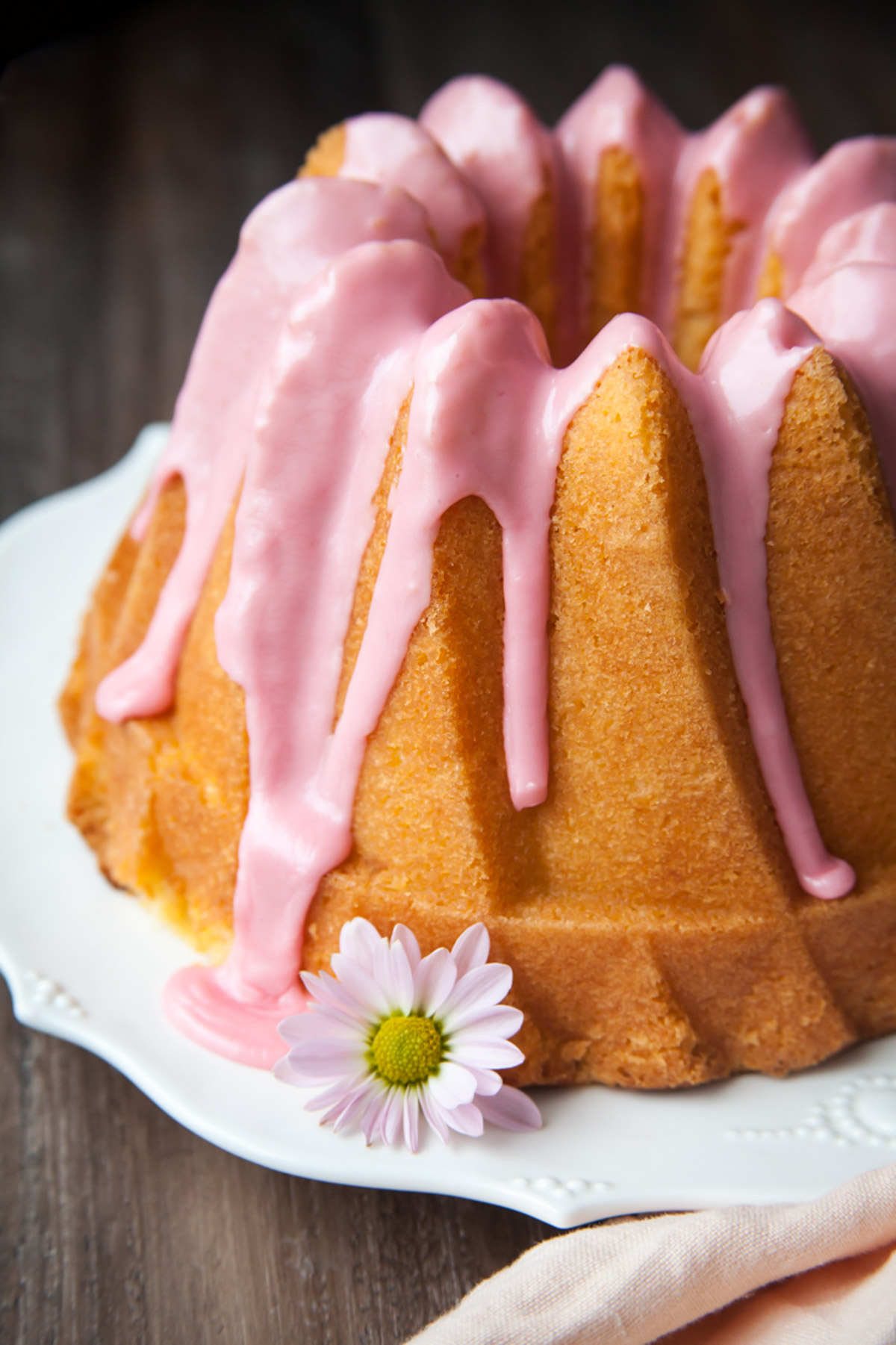
Jump to:
You'll first fall in love with this Orange Bundt Cake for its stunning pink glaze, but it's the tender, moist orange cake that will have you coming back for slice after slice.
This cake is simple to make and even easier to enjoy! Eat it with a cup of tea for breakfast or when you're running out the door for a quick snack.
This recipe utilizes the best of citrus season - using oranges, lemons, and blood oranges. The blood orange glaze is made naturally pink with blood orange juice, so be sure to bake this bundt cake while they are still in season (or freeze blood orange juice in ice cube trays!)
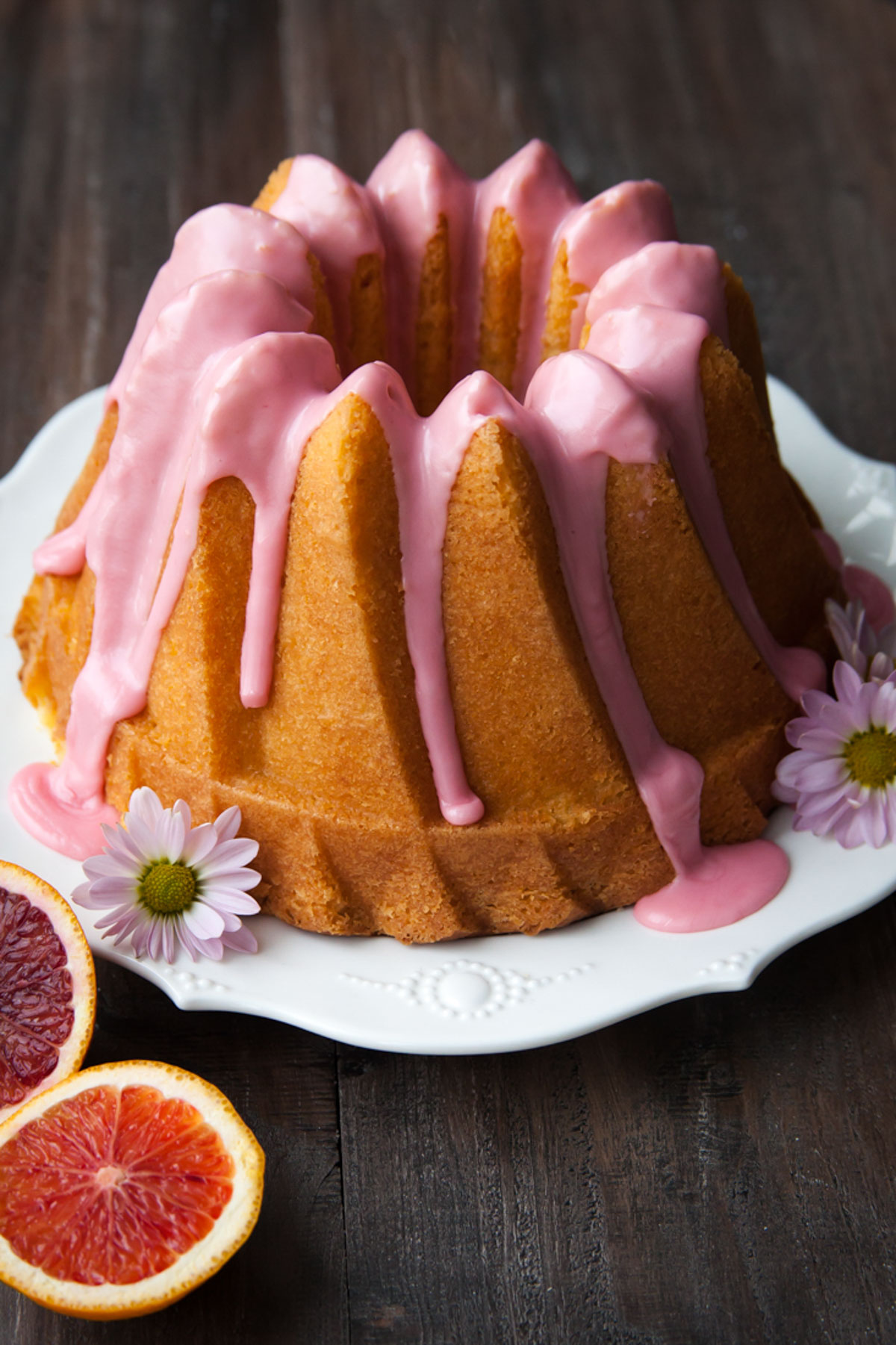
Ingredients
- Cake flour - a combination of flours makes the cake soft and tender
- All-purpose flour
- Unsalted butter
- Lemon
- Orange
- Blood orange - the juice is responsible for the pink glaze, but use any kind of oj in the cake batter
- Granulated sugar
- Eggs
- Avocado or canola oil
- Sour cream - the fat and acidity make the cake both moist and tender
- Milk
- Confectioners' sugar
See recipe card for quantities.
Tools and Equipment
- Stand or hand mixer
- 10 to 12 cup capacity Bundt pan
- Whisk
- Spatula
- Citrus juicer
- Microplane or citrus zester
- General kitchen utensils (measuring cups, spoons, etc.)
How it Works
This recipe started off as a classic pound cake. I’m sure most of you already know this, but the Pound Cake first got its name because the original recipe was made up of a pound of each of the four main ingredients – butter, sugar, flour, and eggs.
In fact, any cake recipe that follows this 1 : 1 : 1 : 1 ratio will yield similar results.
However, swapping some of the butter for oil, using cake flour, and adding an extra egg yolk for richness resulted in an even better crumb and more flavorful Orange Bundt Cake.
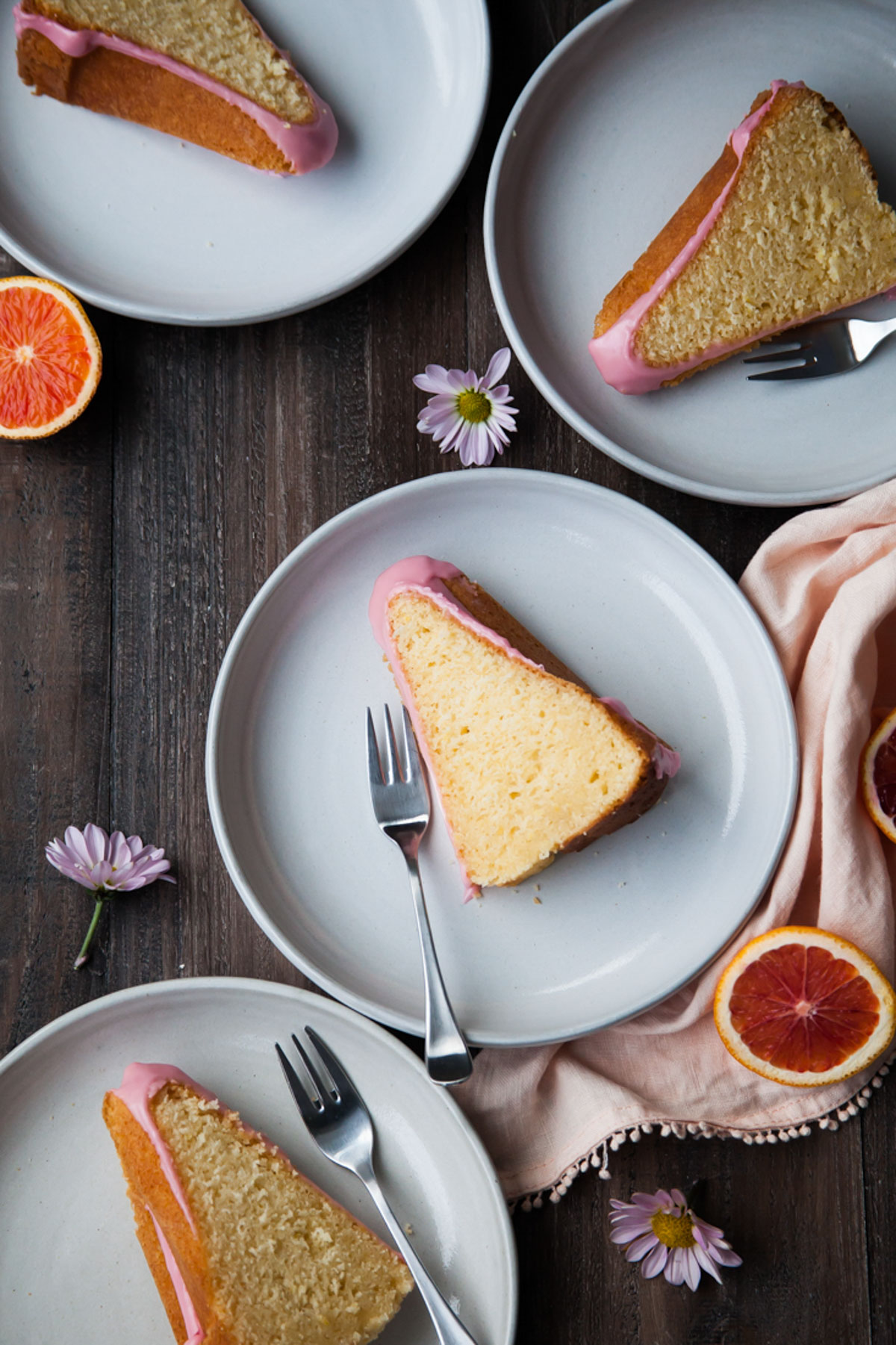
The Best Bundt For the Job
Pound vs Bundt Cake? The only real difference is the pan. Bundt is actually a trademarked name by Nordicware and is more representative of the shape rather than the cake recipe itself.
In my experience, deeper, heavily fluted Bundt pans (like in these photos), yield Bundt cakes that are a touch denser and are not nearly as moist as the same recipe baked in a more classic Bundt pan.
Not only did the more decorative Orange Bundt Cake need an additional 10 to 15 minutes in the oven, according to this article, the leavening agents probably had to work harder in the deep pan and may not have been as effective – resulting in a denser crumb.
Best Tips for Baking with a Bundt Pan
- Start with good pan preparation. To ensure that your cake releases from the pan, use a pastry brush to spread very soft butter into every crevice of the Bundt or tube pan. Sprinkle in a few tablespoons of flour and shake the pan around until the entire inside is covered in flour. Invert the pan over the sink and tap the bottom to release any excess flour.
- Once the cake is done baking, set a timer for 20 minutes. You will need to invert the cake out of the pan while it is still warm.
- To unmold the cake, place a cooling rack or cutting board on top of the pan. Using oven mitts, hold the cooling rack against the pan and flip everything upside down. Give the pan a wiggle until you feel the cake release itself. Gently remove the cake pan and allow the cake to completely cool before adding the glaze.
- If the cake feels stuck, try holding the pan at a 45° angle and tapping the edge to encourage the cake's release. Rotate the pan around and try the other sides.
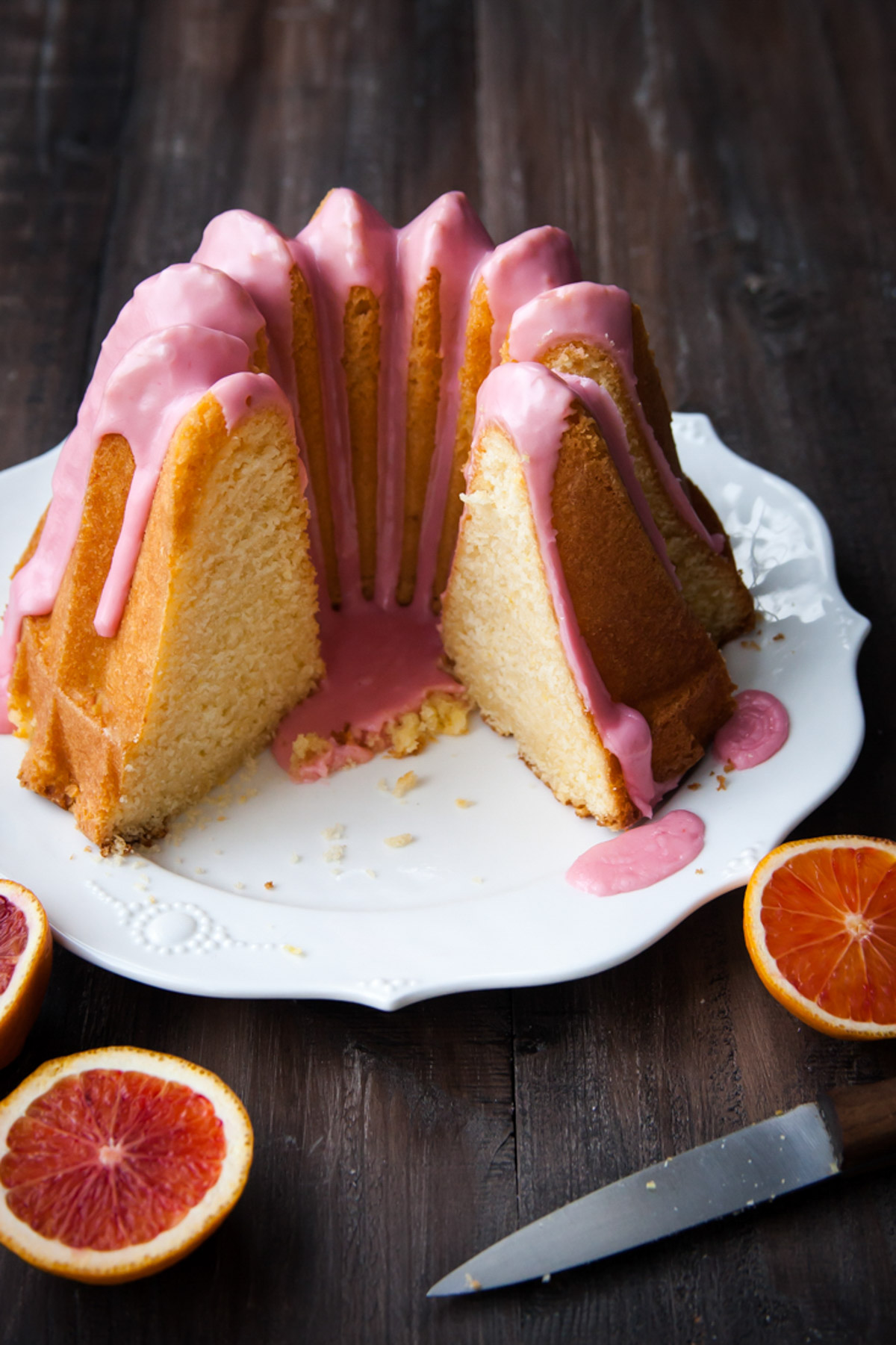
Storage
Store the cake at room temperature (preferably under a cake dome) for up to 3 days.
If left unglazed and undecorated, the cake may be wrapped well in plastic and frozen for one to three months. Thaw in the refrigerator.
Alternatively, freeze individual slices for up to one month. Wrap in plastic then slip into a zip-top bag.
Substitutions
Cake Flour - For every cup of cake flour, measure out 1 cup of all-purpose flour minus 2 tablespoons. Add back 2 tablespoons of either corn starch or arrowroot powder to get 1 cup of cake flour.
Sour Cream - You may use equal parts buttermilk instead of sour cream and regular dairy milk.
Oranges - You may use either regular or blood orange juice for the Orange Bundt Cake recipe. However the blood orange juice is responsible for the pink glaze.
Baking Tips
- Do not allow the cake to completely cool in the pan. Set a timer for 20 minutes as soon as it comes out of the oven. Otherwise, if the cake cools it will be very difficult to come out of the pan.
- Massage the citrus zest and sugar between your fingertips to release all the oils and get max flavor.
- Freeze blood orange juice in ice cube trays to make this cake all year long!
Orange Bundt Cake Recipe FAQs
20 minutes after the cake comes out of the oven, gently release the sides of the cake from the pan with a small rubber spatula as best as you can without cutting into the cake design. Place a cutting board or cooling rack on top then flip the entire cake over.
Yes! You may bake this cake in 8 or 9-inch round pans. Do not fill more than ¾ of the way full. Bake times will vary.
You don't have to use cake flour, but cake flour has a lower percentage of protein compared to all-purpose flour that makes the cake softer. See Substitutions for making your own cake flour alternative.
More Cake Recipes to Try
Recipe
Orange Bundt Cake
Ingredients
Orange Bundt Cake
- 1 ½ cups cake flour
- 1 ½ cups all-purpose flour
- 1 tablespoon baking powder
- ½ tsp baking soda
- 1 cup unsalted butter softened
- zest of 1 lemon
- zest of 1 orange
- 2 cups granulated sugar
- 3 whole eggs
- 2 egg yolks
- ¼ cup grapeseed or canola oil
- ½ cup sour cream
- ½ cup whole milk
- ¼ cup fresh regular or blood orange juice
Blood Orange Glaze
- 3 to 4 tablespoon fresh blood orange juice
- 1 cup confectioner's sugar
Instructions
Orange Bundt Cake
- Pre-heat oven to 350 degrees. Liberally grease then flour all of the nooks and crannies of a Bundt pan and set aside.
- Sift together the dry ingredients and set aside.
- In the bowl of a stand mixer, beat the butter with the paddle attachment on medium speed until smooth. Meanwhile, rub the citrus zest into the sugar with your fingertips until fragrant. Add the sugar (and zest) to the butter and cream together on medium-low until light and fluffy, 3 to 4 minutes).
- Stop the mixer and scrape down the bowl. With the mixer on low, add in the eggs and yolk – one at a time. Add in the oil and mix until combined. Stop the mixer and scrape down the bow.
- With the mixer on low, carefully add in the half of the dry ingredients. Once combined, add in the sour cream, milk, and orange juice.
- Add in the remaining dry ingredients and mix on medium-low until the last bits of flour are incorporated.
- Pour the batter into the prepared pan. Bake for 45 to 55 minutes, until a thin knife inserted into the center comes out clean.
- Cool for only 10 to 15 minutes – or until just cool enough to lift the pan without burning your fingertips. Place a cooling rack or cutting board on top of the cake (the bottom) and flip the cake pan right-side up to unmold the cake. The cake should still be warm or it may stick to the pan if cooled for too long. Loosen the edges gently with a flexible rubber spatula, but refrain from running a knife around the edges or you may cut into the sides of the decorative cake.
Blood Orange Glaze
- Whisk together the juice and sugar until they form a smooth, thick glaze. Add more juice and/or sugar until desired consistency is achieved.

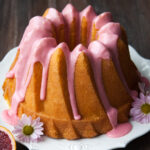
Jill Riaz
This is my 2nd time making this cake. It is sooo incredibly tasty and perfect. Always a stunner too! I’m going to make this every blood orange season I’ve decided. The recipe is perfect - only word of warning is don’t make the same mistake I did (twice) - remember leave room in the bundt pan because it does rise. I had a smoke alarm and major oven clean up after because of overflow haha. Thanks for the great recipe!